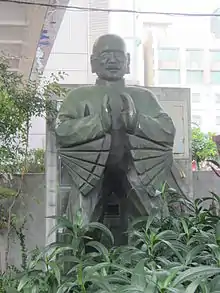Huang Hai-tai
Huang Hai-tai (Chinese: 黃海岱; pinyin: Huáng Hǎidài; 2 January 1901 – 11 February 2007) was a Taiwanese puppeteer.

Born on 2 January 1901, Huang learned the art of puppetry from his father and another puppeteer.[1][2] He was also trained in beiguan music.[3] Huang renamed his father's troupe Wuzhouyuan,[1][2] and developed his own stories and characters, most notably Shi Yan-yun.[1][4] At the start of his career, Taiwan was under Japanese rule, and Huang was limited to public performances that used the Japanese language and portrayed Japanese customs. However, Huang's secretly held private shows told traditional and historic Chinese tales, several of which he had read while in training.[1] Over time, Huang became renowned as a national treasure.[5][6] As his many students, including second son Huang Chun-hsiung, formed their own theatre troupes in the 1950s, they ushered in the Golden Ray era, dominated by more elaborate shows in an attempt to compete with modernized entertainment mediums, such as comic strips, music, film, and television.[7][8][9] Huang was awarded a National Cultural Award in 2000,[10] a National Award for Arts in 2002,[11] and presented with a presidential citation for lifetime achievement in 2004.[12] Later that year, Huang's fifth son, Huang Feng-shih was named to the Legislative Yuan.
Huang fell ill with pneumonia, and died of heart failure on 11 February 2007 in Huwei, Yunlin, aged 106.[2][13] President Chen Shui-bian was one of thousands to attend Huang's funeral.[13][14] He was posthumously featured on a Discovery Channel documentary series, Portrait: Taiwan, in November 2007.[14] Some of Huang's sons and grandsons have also become puppeteers and have added multiple special effects to the shows.[15] The traditional performances have been animated, made into films, and released on YouTube.[16][17]
References
- Han Cheung (27 December 2015). "The master of puppets". Taipei Times. Retrieved 25 December 2017.
- Loa, Iok-sin (12 February 2007). "Famous puppet master Huang Hai-tai dies". Taipei Times. Retrieved 25 December 2017.
- Leymarie, Isabelle (January 1996). "The Master Puppeteer Huang Hai-Tai". UNESCO Courier. Retrieved 26 December 2017 – via Questia and the National Library of Australia.
- Shan, Shelley (3 March 2010). "Puppet show celebrates 40 years". Taipei Times. Retrieved 25 December 2017.
- Bartholomew, Ian (31 July 2009). "Puppets conquer all". Taipei Times. Retrieved 25 December 2017.
- Bartholomew, Ian (28 March 2003). "Hsiluo Bridge celebrates its 50th birthday". Taipei Times. Retrieved 25 December 2017.
- Ruizendaal, Robin (22 July 2001). "How a tradition adapted to survive". Taipei Times. Retrieved 25 December 2017.
- Davison, Gary Marvin; Reed, Barbara E. (1998). Culture and Customs of Taiwan. Greenwood Publishing Group. p. 66. ISBN 9780313302985.
- The Republic of China Yearbook 2010. Government Information Office. 2010. p. 246. ISBN 9789860252781.
- "Puppet Master | Huang Hai-dai". Ministry of Culture. 6 January 2017. Retrieved 16 June 2020.
- "Renowned artist decries lack of government help". Taipei Times. 21 September 2002. Retrieved 25 December 2017.
- Shih, Evelyn (3 July 2004). "Puppet festival will 'shake and astonish'". Taipei Times. Retrieved 25 December 2017.
- Hsiao, Edwin (16 February 2007). "Puppeteer Huang dies at 107". Taiwan Today. Retrieved 26 December 2017.
- Hsu, Jenny W. (6 November 2007). "Discovery Channel to run series on Taiwan's finest". Taipei Times. Retrieved 25 December 2017.
- Lin, Kuo-hsien; Chao, Ching (2 October 2010). "INTERVIEW: Pili mourns loss of valuable puppets to fire". Taipei Times. Retrieved 25 December 2017.
- Ho Yi (13 February 2015). "Film Review: 'The Arti: the Adventure Begins' and 'Lion Dancing 2'". Taipei Times. Retrieved 25 December 2017.
- "Taiwanese puppet show to hit YouTube". Taipei Times. 12 September 2014. Retrieved 25 December 2017.